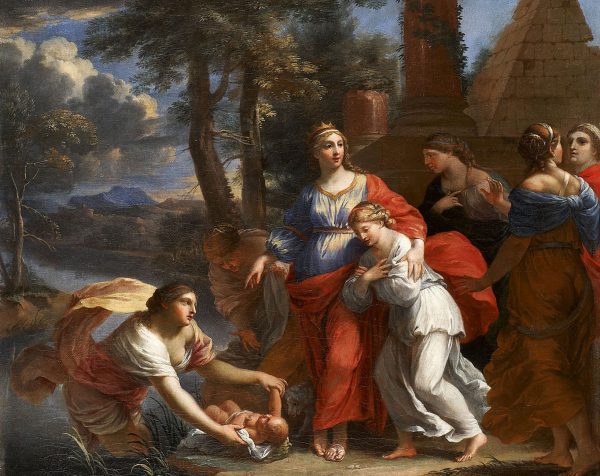Moses rescued from the Nile, 1651-1652
Oil on canvas, H. 0.45 m; W. 0.56 m
Signed beneath the column on the right: C Poerson. In.
Provenance: Private collection, France.
Having first trained under Jean Leclerc (1587-1632/33) in Nancy, Lorraine, Charles Poerson entered Simon Vouet’s workshop in Paris where he stayed, presumably, from 1634 to 1638. He then began a brilliant career and, working beside Eustache Lesueur, he participated in the decorations of the Hôtel Guénégaud, the Arsenal, the Palais Royal and Anne of Austria’s apartments in the Louvre. In 1642 and 1653, he received the prestigious commissions for the “May” of Notre-Dame de Paris. These were large paintings commissioned once a year by the Parisian Goldsmiths’ guild and offered on 1st May to the cathedral in honour of the Virgin Mary . In 1651, Poerson became a member of the French Royal Academy and in 1659, he was named vice-chancellor (one of four), replacing Charles Le Brun.
Between 1645 and about 1660, Poerson worked on several important tapestry sets, studied in detail by Nicole de Reyniès. The History of Moses series included eight pieces and was probably woven five times. About twenty of these tapestries are known of today, and two of them show Moses rescued from the Nile.
The present painting, unpublished till today, is the only known signed modello for this series and allows a definitive attribution of the History of Moses to Poerson.
The composition of our picture is close to the famous tapestry Moses rescued from the Nile, executed on a modello by Simon Vouet (Vouet’s modello, lost today, was engraved by Tortebat in 1665, see Jacques Thuillier, cat. exp. Vouet, Paris, 1990, p. 504-505.). Woven probably in the 1630s, this tapestry kept in the Louvre was part of the Old Testament series, commissioned by Louis XIII. In spite of the resemblance to Vouet’s composition, Poerson, who had left his master’s workshop by 1638 and began his cycle of tapestries in 1651-52, introduced a different vision here. He put more emphasis on the figures than on the landscape, coming closer to the art of François Perrier, whom he had worked with in Vouet’s studio. Whereas the young maid standing in the water seems still close to Vouet’s style, the faces of the ladies standing on the right side are clearly reminiscent of Poussin.
When comparing the present painting to the tapestry, which is almost square, one can see that Poerson’s initial composition has been altered: The pyramid and the two women on the right have been removed.
This scene depicts an episode in the Old Testament (Exodus 2:5–10), in which the infant Moses is discovered and rescued by Pharaoh’s daughter. Pharaoh had ordered all the male children of the Hebrew people to be drowned in the Nile, but Moses’ mother, Jochebed, laid the infant in a basket which she placed in the river. Pharaoh’s daughter, who went to the Nile to bathe with her friends, saw the baby and took pity on him. She rescued Moses and unknowingly entrusted him to his own mother as a nurse.
